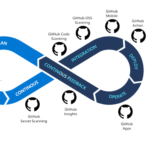In today’s fast-paced digital landscape, large enterprises are under immense pressure to deliver software faster, with higher quality and greater reliability. DevOps has emerged as a transformative approach that bridges the gap between development and operations teams, enabling continuous delivery and innovation. But scaling DevOps across large organizations is a complex challenge that goes beyond simply adopting tools or processes. It requires a deep cultural shift, technical excellence, and organizational alignment.
This comprehensive guide explores how large enterprises can successfully scale DevOps by addressing common challenges, leveraging proven strategies, and embracing emerging trends to future-proof their software delivery pipelines.
Understanding DevOps and Why Scaling Matters
DevOps is a set of practices, cultural philosophies, and tools that increase an organization’s ability to deliver applications and services at high velocity. It emphasizes collaboration, automation, continuous integration and delivery (CI/CD), and rapid feedback loops.
While small teams can adopt DevOps relatively quickly, scaling it in large enterprises-often with thousands of developers, multiple departments, and legacy systems-requires a more strategic approach. Scaling DevOps means extending these principles and practices across the entire organization to achieve consistent, reliable, and automated software delivery at scale.
Key Challenges When Scaling DevOps in Large Enterprises
- Cultural Resistance: DevOps demands a culture of collaboration, transparency, and shared responsibility. Large enterprises often have siloed teams with entrenched mindsets, making cultural change difficult.
- Complex Legacy Systems: Older, monolithic applications and infrastructure can hinder automation and continuous delivery efforts.
- Toolchain Fragmentation: Different teams may use disparate tools, causing integration and standardization challenges.
- Organizational Silos: Separate departments for development, operations, security, and QA can create bottlenecks and slow down delivery.
- Security and Compliance: Enterprises must balance speed with strict regulatory requirements, which can complicate DevOps adoption.
- Skill Gaps: Scaling requires skilled engineers proficient in automation, cloud, and DevOps practices, which may be scarce.
Proven Solutions for Overcoming Barriers
1. Foster a DevOps Culture Across the Organization
Culture is the foundation of DevOps. Leaders must actively promote collaboration between development, operations, security, and business teams. Some effective strategies include:
- Executive Sponsorship: Secure buy-in from top management to drive cultural change and resource allocation.
- Cross-functional Teams: Create integrated teams responsible for the full software lifecycle to break down silos.
- Continuous Learning: Encourage experimentation, blameless postmortems, and knowledge sharing.
- DevOps Champions: Identify and empower internal advocates who can evangelize best practices.
2. Modernize Legacy Systems and Architecture
Large enterprises often struggle with legacy monoliths that slow down deployment. Approaches to modernization include:
- Incremental Refactoring: Gradually break down monoliths into microservices or modular components.
- Adopt Cloud and Containerization: Use cloud platforms and container orchestration (e.g., Kubernetes) to improve scalability and deployment speed.
- API-First Design: Enable interoperability and easier integration across systems.
3. Standardize and Integrate Toolchains
Tool fragmentation can cause inefficiencies. Enterprises should:
- Define a Standard DevOps Toolchain: Select tools for CI/CD, monitoring, infrastructure as code (IaC), and security that integrate well.
- Automate Everything: From code commits to deployments and monitoring, automation reduces human error and speeds delivery.
- Use Platform Engineering: Build internal developer platforms that provide self-service capabilities and standardized environments.
4. Align Organizational Structure and Processes
DevOps requires rethinking traditional organizational boundaries:
- Implement DevSecOps: Integrate security early into the development lifecycle.
- Adopt Agile and Lean Practices: Use iterative development, continuous feedback, and value stream mapping to optimize workflows.
- Measure and Improve: Use metrics like deployment frequency, lead time, and mean time to recovery (MTTR) to track progress and identify bottlenecks.
5. Invest in Skills and Training
Upskilling teams is critical:
- Provide Hands-on Training: Workshops, certifications, and sandbox environments help teams practice DevOps skills.
- Leverage External Expertise: Partner with consultants or hire experienced DevOps engineers.
- Encourage Community Participation: Support attendance at conferences, meetups, and internal knowledge sharing.
Practical Example: Scaling DevOps at a Global Financial Institution
A leading global bank (see the referances section at the end), faced slow software delivery due to siloed teams, legacy systems, and strict compliance requirements. Their approach to scaling DevOps included:
- Cultural Transformation: Leadership launched a company-wide DevOps initiative with executive sponsorship, creating cross-functional squads responsible for end-to-end delivery.
- Legacy Modernization: They adopted a hybrid cloud strategy and containerized key applications to enable faster deployments.
- Toolchain Standardization: The bank implemented a centralized CI/CD platform integrated with automated security scanning and compliance checks.
- Metrics-Driven Improvement: Teams tracked deployment frequency and MTTR, using data to continuously optimize processes.
Within 18 months, the bank improved deployment frequency by 5x and reduced production incidents by 40%, demonstrating the power of a holistic DevOps scale strategy.
Latest Tools and Technologies for Scaling DevOps
- CI/CD Platforms: Jenkins X, GitLab CI, CircleCI, Azure DevOps, and GitHub Actions offer scalable automation pipelines.
- Infrastructure as Code (IaC): Terraform, AWS CloudFormation, and Pulumi enable declarative infrastructure management.
- Container Orchestration: Kubernetes remains the de facto standard for managing containerized workloads at scale.
- Monitoring and Observability: Tools like Prometheus, Grafana, Datadog, and New Relic provide real-time insights into system health.
- Security Automation: Snyk, Aqua Security, and HashiCorp Vault help embed security into DevOps pipelines.
- Developer Platforms: Internal platforms built with Backstage or OpenShift provide self-service environments and governance.
Challenges Practitioners Face and How to Address Them
- Resistance to Change: Overcome by clear communication, leadership example, and demonstrating quick wins.
- Tool Overload: Avoid by focusing on integration and reducing complexity rather than adopting every new tool.
- Security vs. Speed: Implement DevSecOps practices to automate security checks without slowing delivery.
- Scaling Automation: Build reusable pipelines and templates to avoid duplication and ensure consistency.
- Maintaining Quality: Use automated testing, code reviews, and continuous feedback loops to uphold standards.
The Future Outlook: Emerging Trends in Scaling DevOps
- AI and Machine Learning Integration: AI-powered tools will increasingly automate code reviews, anomaly detection, and predictive analytics to optimize DevOps workflows.
- GitOps and Declarative Operations: Managing infrastructure and applications through Git repositories will become more widespread for better traceability and control.
- Platform Engineering Growth: Enterprises will invest more in internal developer platforms to simplify and standardize developer experiences.
- Increased Focus on Security and Compliance Automation: Regulatory requirements will drive more advanced automated security and compliance checks.
- Edge Computing and DevOps: As edge deployments grow, DevOps practices will evolve to manage distributed, heterogeneous environments.
Conclusion
Scaling DevOps in large enterprises is a multifaceted journey that requires more than just adopting new tools. It demands a cultural transformation, modernization of legacy systems, organizational realignment, and continuous learning. By addressing these challenges with proven strategies and leveraging the latest technologies, enterprises can unlock the full potential of DevOps to accelerate innovation, improve quality, and deliver value faster.
Enterprises that invest in building a strong DevOps foundation today will be well-positioned to thrive in the increasingly competitive digital future.
References & Further Reading
- "Accelerate: State of DevOps 2023" by DORA
- "Team Topologies" by Skelton & Pais
- CNCF Cloud Native Landscape Report
- ING Agile Transformation



